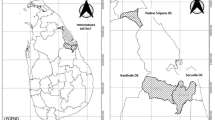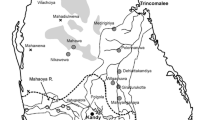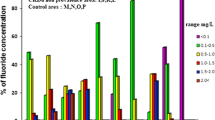Abstract
Chronic renal failure (CRF), in the main agricultural region under reservoir based cascade irrigation in Sri Lanka has reached crisis proportion. Over 5,000 patients in the region are under treatment for CRF. The objective of this study is to establish the etiology of the CRF. Concentrations of nine heavy metals were determined in sediments, soils of reservoir peripheries, water and Nelumbo nucifera (lotus) grown in five major reservoirs that supply irrigation water. All five reservoirs carried higher levels of dissolved cadmium (Cd), iron (Fe) and lead (Pb). Dissolved Cd in reservoir water ranged from 0.03 to 0.06 mg/l. Sediment Cd concentration was 1.78–2.45 mg/kg. No arsenic (As) was detected. Cd content in lotus rhizomes was 253.82 mg/kg. The Provisional Tolerable Weekly Intake (PTWI) of Cd based on extreme exposure of rice is 8.702–15.927 μg/kg body weight (BW) for different age groups, 5–50 years. The PTWI of Cd due to extreme exposure of fish is 6.773–12.469 μg/kg BW. The PTWI on a rice staple with fish is 15.475–28.396 μg/kg BW. The mean urinary cadmium (UCd) concentration in CRF patients of age group 40–60 years was 7.58 μg Cd/g creatinine and in asymptomatic persons UCd was 11.62 μg Cd/g creatinine, indicating a chronic exposure to Cd. The possible source of Cd in reservoir sediments and water is Cd-contaminated agrochemicals. The CRF prevalent in north central Sri Lanka is a result of chronic dietary intake of Cd, supported by high natural levels of fluoride in drinking water, coupled with neglecting of routine de-silting of reservoirs for the past 20 years.




Similar content being viewed by others
References
Alloway, B. J. (Ed.) (1995). Heavy metals in soils (2nd ed.). New York: Blackie.
Atapattu, N. (2006). Renal failure crisis in North Central Province. The Island, 26, 234, 9th October 2006.
Athuraliya, T. N. C., Abeysekara, T., Kumarasiri, R., Abeysekara, C., Gooneratne, A., & Bandara, P. (2003). A baseline study on early renal diseases in a selected community of the North-Central Province of Sri Lanka. Research report, Faculty of Medicine, University of Peradeniya, Sri Lanka.
Bandara, J. M. R. S. (2007). Nature farming. Kandy: COMPAS/ECO.
Bates, C. F., & Sharp, R. D. (1983). A proposal for estimation of soil leaching and leaching constants for use in assessment models. Journal of Environmental Quality, 12, 17–28.
Baycu, G. (2002). Phytochelatin biosynthase and cadmium detoxification. Journal of Cell & Molecular Biology (Turkey), 1, 45–55.
Benoit, D. A., Leonard, E. N., Christensen, G. M., & Fiandt, J. T. (1976). Toxic effects of cadmium on three generations of brook trout (Salvelinus fontinalis). Transactions of the American Fishery Society, 105, 550–560.
Beveridge, M. (1984). Cage and pen fish farming: Carrying capacity models and environmental impact. FAO Fish Technical Paper.
Boyd, C. E., & Tucker, C. S. (1992). Water quality and pond soil analysis for aquaculture. Alabama: Alabama University.
Codex Alimentarius Commission (2002). Report of the 34th session of the Codex Committee on Food Additives and Contaminants, Rotterdam, The Netherlands, 11–15 March, 2002.
Curtis, L. R., & Smith, B. W. (2002). Heavy metal in fertilizers. Considerations for setting regulations in Oregon. Retrieved: 02-11-2006.
de Zoysa, T. (2002). Water quality of Parakrama Samudraya (reservoir). Dissertation, Postgraduate Institute of Agriculture, University of Peradeniya. Sri Lanka.
Dissanayake, C. B. (2006). Essays on science and society: Global voices of science: Of stones and health: Medical geology in Sri Lanka. Science, 309(5736), 883–885.
Dissanayake, C. B., & Weerasooriya, S. V. R. (1986). The environmental chemistry of Mahaweli River, Sri Lanka. International Journal of Environmental Studies, 28, 207–223.
Donkin, S. G., Ohlson, D. L., & Teaf, C. M. (2000). Properties and effects of metals. In P. L. Williams, R. C. James, & S. M. Roberts (Eds.), Principles of Toxicology: Environmental and Industrial applications (2nd ed., pp. 325–343). Wiley.
Ekstrand, J., Ehrnebo, M., Whitford, G. M., & Järnberg, P. O. (1980). Fluoride pharmacokinetics during acid-base balance changes in man. European Journal of Clinical Pharmacology, 18(2), 189–194.
El-Demerdash, F. M., & Elagamy, E. I. (1999). Biological effects in Tilapia nilotica fish as indicators of pollution by cadmium and mercury. International Journal of Environmental Health Research, 9(3), 173–186. doi:10.1080/09603129973146.
FAO (2006). Appendix A. Nutrition and related indictors in South Asia. FAO Corporate Document Repository.
Fertilizer Secretariat of Sri Lanka (2006). Annual Report – 2004.
Greenberg, A. E., Clesceri, L. S., & Eaton, A. D. (Eds.) (1992). Standard methods for the examination of water and wastewater (18th ed.) 2005. Washington, DC: American Public Health Association, American Water Works Association and Water Environment Federation.
Health – Canada (1985). Sample preparation by dry ashing for the determination of various elements by flame atomic absorption spectroscopy. Health Protection Branch Laboratories, Bureau of Nutritional Sciences Ottawa, LPFC-137.
Herath, K. R. P. K., Illeperuma, O. A., Dharmagunawardhane, H. A., & Haller, K. J. (2005, October). Environmental health risk for the chronic renal failure in Sri Lanka. Paper presented at the 31st Congress on Science and Technology of Suranaree University of Technology, Thailand.
Holcombe, G. W., Benoit, D. A., Leonard, E. N., & McKim, J. M. (1976). Long-term effects of lead exposure on three generations of brook trout (Salvelinus fontinalis). Journal of the Fish Research Board Canada, 33, 1731–1741.
Ikeda, M., Ezaki, T., Tsukahara, T., Moriguchi, J., Furuki, K., Fukai, Y., Okamoto, S. & Sakurai, H. (2003). Threshold levels of urinary cadmium in relation to increases in urinary β2-microglobulin among general Japanese populations. Toxicological Letters, 137, 135–141.
Jauncy, K., & Ross, B. (1982). A guide to tilapia feeds and feeding. Scotland: Institute of Aquaculture, University of Sterling.
JEFCA (2003, June). Joint FAO/WHO Expert Committee on Food Additives. Report on the 61st Session of JEFCA. Rome, Italy.
JECFA (2004). WHO Food additive series 52, 2004. Contaminants Cadmium Addendum.
Jin, T., Nordberg, M., Frech, W., Dumont, X., Bernard, A., Ye, T. T., Kong, Q., Wang, Z., Li, P., Lundstrom, N. G., Li, Y., & Nordberg, G. F. (2002). Cadmium biomonitoring and renal dysfunction among a population environmentally exposed to cadmium from smelting in China (ChinaCad). Bimetals, 15(4), 397–410.
Kaviraj, A., & Ghosal, T. K. (1998). Effect of compost manure on the body burden of cadmium and growth of common carp, Cyprinus carpio (L). Aquaculture Research, 29, 555–561.
Kong, K. Y., Cheung, K. C., Wong, C. K., & Wong, M. H. (2005). Residues of DDTs, PAHs and some heavy metals in fish (Tilapia) collected from Hong Kong and mainland China. Journal of Environmental Science Health. A Toxic Hazardous Substances & Environmental Engineering, 40(11), 2105–2115. PMID: 16287644 [PubMed – indexed for MEDLINE].
Liyanege, C. E., Thabrew, M. I., & Kuruppuarachchi, D. S. P. (2000). Nitrate pollution in ground water of Kalpitiya. Journal of the National Science Council of Sri Lanka, 28(2), 101–112.
Locus, J., Naya, L., Ramos, J., Clemente, M., Matamoros, M. A., & Becana, M. (2006). A reassessment of substrate specificity and activation of phytochelatin synthase from model plants by physiologically relevant metals. Plant Physiology, 140, 1213–1221.
Loganathan, P., & Hedley, M. J. (1997). Downward movement of cadmium and phosphorous from phosphate fertilizers in a pasture soil in New Zealand. Environmental Pollution, 95(3), 319–324.
Mahaweli Authority of Sri Lanka (2005). Economic and social infrastructure. Colombo, Sri Lanka: Land cultivated under Mahaweli development programme.
Matsuda, K., Kobayashi, E., Okubo, Y., Suwazono, Y., Kido, T., Nishijo, M., Nakagawa, H., & Nogawa, K. (2003). Total cadmium intake and mortality among residents in the Jinzu River Basin, Japan [Electronic version]. Archives of Environmental health, April 2003.
Middendorf, P. J., & Williams, P. L. (2000). Nephrotoxicity: Toxic responses of the kidney. In P. L. Williams, R. C. James, & S. M. Roberts (Eds.), Principles of toxicology: environmental and industrial applications (2nd ed., pp. 129–143). Wiley.
Mueller, P. W., Price, R. G., & Finn, W. F. (1998). New approaches for detecting thresholds of human nephrotoxicity using cadmium as an example. Environmental Health Perspectives, 106(5), 227–230.
Murphy, B. R., Atchison, G. J., McIntosh, A. W., & Kolar, D. J. (1978). Cadmium and zinc content of fish from an industrially contaminated lake. Journal of Fish Biology, 13, 327–335.
Natural Resources of Sri Lanka (1991). In M. F. Baldwin (Ed.), Conditions and trends. Report prepared for the Natural Resources, Energy and Science Authority of Sri Lanka (presently NSF). Keels Business Ltd. Colombo.
Nogawa, K., Kobayashi, E., & Honda, R. (1979). A study of the relationship between cadmium concentrations in urine and renal effects of cadmium. Environmental Health Perspectives, 28, 161–168.
Perera, W. (2006, December). Water pollution by pesticides. Paper presented at the seminar on Impact of Agriculture on Sri Lankan Environment and remedial measurers by the integration of IK with modern technology, Kandy, Sri Lanka.
Piyasiri, S. (1995). Eutrophication and blue-green algal problem in Kotmale reservoir in Sri Lanka. In K. H. Timotius & F. Golthenboth (Eds.), Tropical limnology 2 (pp. 161–169). Indonesia: Satya Wacanan Christian University.
Premarathna, H. M. P. L., Hettiarachchci, G. M., & Indraratne, S. P. (2005). Accumulation of cadmium in intensive vegetable growing soils in the up-country. Tropical Agriculture Research, 17, 93–103.
Rathnayake, I. M., & Weerahewa, J. (2005). Determinants of nutritional status among pre-school children in Sri Lanka. Tropical Agriculture Research, 17, 148–161.
Satarug, S., Haswell-Elkins, M. R., & Moore, M. (2000). Safe levels of cadmium intake to prevent toxicity in human subjects: Review Article. British Journal of Nutrition, 84(6). Copyright Nutrition Society, 2000, Published by CABI Publishing on behalf of the Nutrition Society, With MEDLINE® links. Retrieved on Nov. 12th 2006.
Satarug, S., & Moore, M. R. (2004). Adverse health effects of chronic exposure of cadmium in foodstuffs and cigarette smoke. Environment Health Perspective, 112(10), 1099–1103.
Schroeder, G. L. (1978). Autotrophic and heterotrophic production of micro-organisms in intensively manured fish ponds and related fish yields. Aquaculture, 14, 303–325.
Shigematsu, I., Minowa, M., Yoshida, T., & Miyamoto, K. (1979). Recent results of health examinations on the general population in cadmium-polluted and control areas in Japan [Electronic version-JSTOR]. Environment Health Perspectives, 28, 205–210.
Simmons, R. W., Pongasakul, P., Saiyasitpanich, D., & Klinphoklap, S. (2005). Elevated levels of cadmium and zinc in paddy soils and elevated levels of cadmium in rice grain downstream of a zinc mineralized area in Thailand: Implication for public health. Environmental Geochemistry and Health, 27, 501–511.
Tennakoon, M. U. A. (2006). In Proceedings of the Seminar on Impact of Modern Agriculture on Sri Lankan Environment, 2005, December, Kandy, Sri Lanka.
U.S. Environmental Protection Agency (1983). Metals (atomic absorption methods) sample handling and preservation. In USEPA (Ed.), Methods for chemical analysis of water and wastes (pp. 58–61). EPA-600/4-79-020, Ohio, USA.
Watanabe, Y., Kobayashi, E., Okubo, Y., Suwazono, Y., Kido, T., & Nogawa, K. (2002). Relationship between cadmium concentration in rice and renal dysfunction in individual subjects of the Jinzu River basin determined using a logistic regression analysis. Toxicology, 172, 93–101.
WHO (1972). Evaluation of mercury, lead, cadmium and the food additives amaranth, diethylpyrocarbonate, and octyl gallate. Joint FAO/WHO Expert Committee on Food Additives. WHO Food Additives Series, 1972, No. 4.
WHO (2000). Air quality guide lines (2nd ed.). WHO Regional Office of Europe, Copenhagen, Denmark.
Wickramaarachchi, W. D. N. (2005). Irrigation water quality along the cascade system in the north east dry zone of Sri Lanka. Dissertation, Postgraduate Institute of Agriculture, University of Peradeniya, Sri Lanka.
Acknowledgments
We are grateful to COMPAS, the Netherlands, for the financial support for heavy metal analysis, Dr. S. Satarug of University of Queensland, Brisbane, Australia, for personally visiting CRF patients and her unreserved support for the analysis of cadmium, Dr. Chaturanga Bamunuarachchige of Board of Study in Plant Protection, PGIA, University of Peradeniya, and Dr. Ganga Hettiarachchi, University of Adelaide, Australia, for kind assistance in the analysis of cadmium and the encouragement extended to us.
Author information
Authors and Affiliations
Corresponding author
Rights and permissions
About this article
Cite this article
Bandara, J.M.R.S., Senevirathna, D.M.A.N., Dasanayake, D.M.R.S.B. et al. Chronic renal failure among farm families in cascade irrigation systems in Sri Lanka associated with elevated dietary cadmium levels in rice and freshwater fish (Tilapia). Environ Geochem Health 30, 465–478 (2008). https://doi.org/10.1007/s10653-007-9129-6
Received:
Accepted:
Published:
Issue Date:
DOI: https://doi.org/10.1007/s10653-007-9129-6




